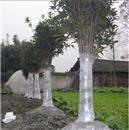Bacterial wilt of eucalyptus and its control

Bacterial wilt of eucalyptus and its control Ralstonia solanacearum (Smith) Yabuuchi is a serious bacterial wilt disease of eucalyptus in South China. In the early stage of the disease, the seedlings generally wilted, followed by leaf withering, the seedlings died rapidly, the roots of the diseased plants were necrotic, waterlogged, smelly, and milky yellow pus appeared after cross-cutting. After the young trees were infected, the leaves wilted, lost green and did not fall off, brown or dark brown spots appeared on the stem, branch and stem surface, the xylem gradually changed to dark brown, the root rotted, the cortex exfoliated, and milky yellow or light white bacterial pus was produced on the surface. Eucalyptus infected with this disease will cause plant death. The onset time is mostly from April to November, and the peak is in the high temperature and rainy season. Prevention and control methods: (1) strengthen quarantine to control the spread of bacterial wilt. Strengthening the tracking and detection during the seedling raising period and strict quarantine of eucalyptus seedlings out of the nursery can effectively prevent the long-distance spread of bacterial wilt and the spread of the disease. Eucalyptus seedlings that have been infected with bacterial wilt in the nursery should not be transferred to planting areas for afforestation to avoid the spread and spread of pathogens. (2) biological control. Control of bacterial wilt of eucalyptus by Pseudomonas aeruginosa and mycorrhiza, and control of pathogenic bacterial wilt by non-pathogenic bacterial wilt bacteria. (3) chemical control. Different application methods such as soil disinfection, root irrigation treatment and spraying treatment can be selected. The control effect of root irrigation treatment is usually the best. the commonly used agents for root irrigation treatment are: 72% agricultural streptomycin wettable powder, 53.8%, 86.2% cuprous oxide wettable powder, 10% difenoconazole (Shigao), 25% Qingkuling wettable powder. Complex ammonia copper, green de bao, can kill, DT, carbendazol, Chuanhua 018 (thiocarbazol, leaf kumazol, dikuning, leaf Qingshuang, leaf kuning), thiram, ethyl frost green, leaf withering, etc. If the root is irrigated once every 7-10 days for 2-3 times, a good control effect can be obtained. The commonly used agents for soil disinfection are: formalin solution, 20% limewater, lime powder, bleach, carbendazim, methyl bromide, potassium permanganate, ammonium bicarbonate and so on. These agents can significantly limit the reproduction of bacterial wilt in the soil and reduce the incidence of bacterial wilt. It has a certain effect on the control and spread of bacterial wilt.
- Prev

Cultivation and Utilization of Osmanthus fragrans
Sweet-scented osmanthus is a small evergreen tree, is a precious ornamental aromatic plant, autumn flowering, fragrance is far, refreshing. Sweet-scented osmanthus can be extracted aromatic oil, is a valuable spice. Flavors and flavor products prepared with sweet-scented osmanthus pure oil, such as sweet-scented osmanthus wine, sweet-scented osmanthus sugar, sweet-scented osmanthus candied fruit, perfume, soap, etc., sell well in domestic and foreign markets. 1...
- Next

Triazole control of chrysanthemum rust
Chrysanthemum rust mainly harms leaves and stems. At the beginning of the disease, light yellow spots appeared on the back of the leaves, and raised light brown or ferruginous blister appeared on the leaf surface, which was slightly sunken, and soon the blister process cracked and scattered yellowish brown powder. Warmth and high humidity are beneficial to the disease. There are more rainy seasons and late autumn from April to May.
Related
- Fuxing push coffee new agricultural production and marketing class: lack of small-scale processing plants
- Jujube rice field leisure farm deep ploughing Yilan for five years to create a space for organic food and play
- Nongyu Farm-A trial of organic papaya for brave women with advanced technology
- Four points for attention in the prevention and control of diseases and insect pests of edible fungi
- How to add nutrient solution to Edible Fungi
- Is there any good way to control edible fungus mites?
- Open Inoculation Technology of Edible Fungi
- Is there any clever way to use fertilizer for edible fungus in winter?
- What agents are used to kill the pathogens of edible fungi in the mushroom shed?
- Rapid drying of Edible Fungi

